
Everything seems to be connected to the Internet these days. Once, it was just our desktop computers that were able to go online, however now it seems even the most mundane of objects have some sort of way to access the online world, from kids’ toys to kitchen appliances. And, this concept of “The Internet of Things” has given rise to the whole “Smart Home” technology movement, where we are now starting to be able to control and monitor all sorts of connected devices (both solo and in conjunction with each other) in our living spaces. If the whole Smart Home thing has begun to pique your own curiosity, but you would like to start off simple (with the option of expanding the smart setup later), you should definitely continue reading my review of the iHome Smart Plug and 5-in-1 Smart Home Monitor.
The iHome iSP8W Wi-Fi Smart Plug with Remote
The first of the two iHome devices I got to test out was the iSP8W Wi-Fi Smart Plug with Remote. This is a pretty handy and simple little smart gadget, seemingly designed especially for people who want to test out the Smart Home tech waters before really diving into the connected revolution.
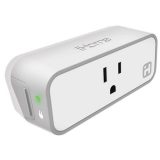
Essentially, the iHome Smart Plug turns any appliance or device in your home into a smart device. It’s a little like an advanced version of those timer plugs you buy to try and fool burglars into thinking you’re home, because your lights turn on and off at the exact same time every day. However, this little plug is remote controlled! The iHome Smart Plug doesn’t need a hub, like with a lot of Smart Home products, as it is Wi-Fi enabled and works with your existing wireless router. Once you download and install the iHome app (more on that below) you’ll be able to remotely turn on and off any device plugged into the, er, plug. If you don’t feel like using your phone, the plug comes with a handy remote as well. You can group multiple plugs together and create zones or ‘scenes” where you can control a room full of devices with just a tap on your smart device. The app lets you monitor the power consumption of your various devices, too, so you can make smart energy choices for your home. Best of all, the device works with Nest Learning Thermostats, and Apple Homekit, so it is expandable and can be used in conjunction with other connected devices. The Apple HomeKit compatibility also means you can control the smart plug using Siri and your voice.
Out of the Box
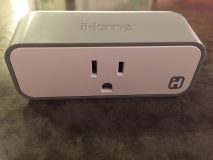
The box comes with the smart plug and the remote, as well as the quick-start manual. The plug’s design is thoughtful enough that you would be able to plug two of these into any wall socket.
Setting It Up
So, 99 per cent of the time, I have no trouble with setting up any Wi-Fi or Bluetooth device on my phone. That wasn’t the case unfortunately with the iHome Smart Plug. After I downloaded the control app, the instructions were a little unclear about where to find and enable the device; however, after a while I was eventually able to get it working. The app is easy to use, though, and enables you to turn on and off your device(s) or set up zones.
iHome ISS50 5-in-1 Smart Home Monitor
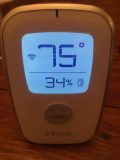
Now, while the Smart Plug may seem nifty, and a great way to try out Smart Home tech, it is pretty boring, that is unless you pair it with the iHome 5-in-1 Smart Home Monitor. This little device uses precision sensors to monitor motion, temperature, light, sound and humidity in your home. Once set up with the iHome Control app, you’ll be able to receive real-time notifications and data right on your smart device. And, when paired with your iHome Smart Plug, you can do all sorts of fun things. Plug a fan into the smart plug, pair it with the sensor, and tell it to turn on the fan when the room hits a certain temperature. Or, set the two devices up to a light, and have the sensor turn the light on when someone comes into the room. As with the Smart Plug, the sensor does not require a hub, and works just with your existing Wi-Fi router. It does, however, also work with Nest thermostats, and the Apple HomeKit devices, so you’ve got that great expandability, versatility, and the option to use Siri voice control.
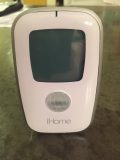
Out of the Box
In the box you’ll find the sensor unit, a USB cable and plug, plus the ever-popular quick-start guide. The sensor unit is a small white rectangular box that fits in your hand. It looks a bit like a little desktop computer speaker. On the front is a screen with a digital display that gives you your temperature and humidity, as well as indicators for sound and motion, pus your Wi-Fi signal. Below the screen is a round motion sensor.
Setting It Up
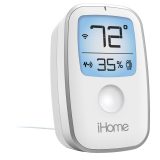
Again, I had a bit of trouble setting it up with the app, and I had to turn my phone on and off a couple times and mess with settings to get to see the device. I don’t mind having to work a bit to make something work, however, I could see some first-timers getting a bit frustrated with the process.
The Final Word
The iHome Smart Plug and remote and 5-in-1 Smart Home Monitor are ideal for those who want to ease into the Smart Home tech world. They are simple to use, pretty straight-forward, and they work with the all-important Nest and Apple HomeKit stuff, which is a big plus when you are considering future expansion of your Smart Home setup. My only complaint would be the app setup, and manual instructions for such, which did have me a bit confused when things didn’t just work right away as usual. It’s a small complaint, however, as I said, it may be a deterrent to those who are less tech-savvy.
What do you think of my review? Is this a product you’d like to use, or are smart homes still too futuristic for you? Let me know your thoughts in the comment section below.



